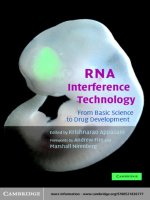RNA Interference Technology FROM BASIC SCIENCE TO DRUG DEVELOPMENT ppt
Bạn đang xem bản rút gọn của tài liệu. Xem và tải ngay bản đầy đủ của tài liệu tại đây (21.66 MB, 561 trang )
RNA INTERFERENCE TECHNOLOGY
RNA Interference (RNAi) technology has rapidly become one of the key
methods used in functional genomics. RNAi is used to block the expression
of genes and create phenotypes that can potentially yield clues about the
function of these genes. In the postgenomic era, the elucidation of the phys-
iological function of genes has become the rate-limiting step in the quest
to develop “gene-based drugs” and RNAi could potentially play a pivotal
role in the validation of such novel drugs. In this cutting-edge overview,
the basic concepts of RNAi biology are discussed, as well as the current and
potential applications. Leading experts from both academia and industry
have contributed to this invaluable reference for graduate students, post-
docs, and researchers from academia wanting to initiate RNAi research in
their own labs, as well as for those working in research and development
in biotech and pharmaceutical companies who need to understand this
emerging technology.
Krishnarao Appasani is the Founder and Chief Executive Officer of Gene-
Expression Systems, a gene discovery company focusing on functional ge-
nomics in cancer research.
RNA Interference Technology
FROM BASIC SCIENCE TO DRUG DEVELOPMENT
Edited by
Krishnarao Appasani
GeneExpression Systems, Inc.
Forewords by
Andrew Fire
Stanford University, co-discoverer of RNAi
and
Marshall Nirenberg
National Institutes of Health
Winner of the Nobel Prize in Physiology or Medicine, 1968
cambridge university press
Cambridge, New York, Melbourne, Madrid, Cape Town, Singapore, São Paulo
Cambridge University Press
The Edinburgh Building, Cambridge cb2 2ru, UK
First published in print format
isbn-13 978-0-521-83677-7
isbn-13 978-0-511-08221-4
© Cambridge University Press 2005
Information on this title: www.cambrid
g
e.or
g
/9780521836777
This book is in copyright. Subject to statutory exception and to the provision of
relevant collective licensing agreements, no reproduction of any part may take place
without the written permission of Cambridge University Press.
isbn-10 0-511-08221-5
isbn-10 0-521-83677-8
Cambridge University Press has no responsibility for the persistence or accuracy of
urls for external or third-party internet websites referred to in this book, and does not
guarantee that any content on such websites is, or will remain, accurate or appropriate.
Published in the United States of America by Cambridge University Press, New York
www.cambridge.org
hardback
eBook (NetLibrary)
eBook (NetLibrary)
hardback
In memory of my parents
For my teachers, family members
and especially my wife Shyamala and sons Raakish and Raghu
Contents
Foreword by Andrew Fire page xi
Foreword by Marshall Nirenberg xiii
List of Contributors xv
Introduction 1
Krishnarao Appasani
Section one. Basic RNAi, siRNA, microRNAs and gene-silencing
mechanisms
1 RNAi beginnings. Overview of the pathway in
C. elegans 17
Alla Grishok
2 Dicer in RNAi: Its roles in vivo and utility in vitro 29
Jason W. Myers and James E. Ferrell, Jr.
3 Genes required for RNA interference 55
Nathaniel R. Dudley, Ahmad Z. Amin, and Bob Goldstein
4 MicroRNAs: A small contribution from worms 69
Amy E. Pasquinelli
5 miRNAs in the brain and the application of RNAi
to neurons 84
Anna M. Krichevsky, Shih-Chu Kao, Li-Huei Tsai, and Kenneth S. Kosik
Section two. Design, synthesis of siRNAs
6 Design and synthesis of small interfering RNA (siRNA) 103
Queta Boese, William S. Marshall, and Anastasia Khvorova
7 Automated design and high throughput chemical synthesis
of siRNA 118
Yerramilli V. B. K. Subrahmanyam and Eric Lader
8 Rational design of siRNAs with the Sfold software 129
Ye Ding and Charles E. Lawrence
9 Enzymatic production of small interfering RNAs 139
Muhammad Sohail and Graeme Doran
vii
viii Contents
Section three. Vector development and in vivo, in vitro and in ovo
delivery methods
10 Six methods of inducing RNAi in mammalian cells 147
Kathy Latham, Vince Pallotta, Lance Ford, Mike Byrom, Mehdi Banan,
Po-Tsan Ku, and David Brown
11 Viral delivery of shRNA 161
Ying Mao, Chris Mello, Laurence Lamarcq, Brad Scherer, Thomas Quinn,
Patty Wong, and Andrew Farmer
12 siRNA delivery by lentiviral vectors: Design and applications 174
Oded Singer, Gustavo Tiscornia, and Inder Verma
13 Liposomal delivery of siRNAs in mice 186
Mouldy Sioud and Dag R. Sørensen
14 Chemical modifications to achieve increased stability and sensitive
detection of siRNA 194
Philipp Hadwiger and Hans-Peter Vornlocher
15 RNA interference in postimplantation mouse embryos 207
Frank Buchholz, Federico Calegari, Ralf Kittler, and Wieland B. Huttner
16 In ovo RNAi opens new possibilities for functional genomics in
vertebrates 220
Dimitris Bourikas, Thomas Baeriswyl, Rejina Sadhu, and Esther T. Stoeckli
Section four. Gene silencing in model organisms
17 Practical applications of RNAi in C. elegans 235
Karen E. Stephens, Olivier Zugasti, Nigel J. O’Neil, and Patricia E. Kuwabara
18 Inducible RNAi as a forward genetic tool in Trypanosoma brucei 247
Mark E. Drew, Shawn A. Motyka, James C. Morris, Zefeng Wang,
and Paul T. Englund
19 RNA-mediated gene silencing in fission yeast 257
Greg M. Arndt
20 RNA silencing in filamentous fungi: Mucor ciccinelloides
as a model organism 270
Rosa M. Ruiz-V
´
azque
21 RNAi and gene silencing phenomena mediated by viral suppressors
in plants 280
Ramachandran Vanitharani, Padmanabhan Chellappan, and
Claude M. Fauquet
Section five. Drug target validation
22 Delivering siRNA in vivo for functional genomics and novel
therapeutics 303
Patrick Y. Lu and Martin C. Woodle
23 The role of RNA interference in drug target validation: Application
to Hepatitis C 318
Antje Ostareck-Lederer, Sandra Clauder-M
¨
unster, Rolf Thermann, Maria
Polycarpou-Schwarz, Marc Gentzel, Matthias Wilm, and Joe D. Lewis
24 RNAi in the drug discovery process 331
Steven A. Haney, Peter Lapan, Jeff Aalfs, Chris Childs, Paul Yaworsky, and
Chris Miller
Contents ix
25 RNA interference technology in the discovery and validation of
druggable targets 347
Neil J. Clarke, John E. Bisi, Caretha L. Creasy, Michael K. Dush, Kris J.
Fisher, John M. Johnson III, Christopher J. A. Ring, and Mark R. Edbrooke
Section six. Therapeutic and drug development
26 RNAi-mediated silencing of viral gene expression and replication 363
Derek M. Dykxhoorn
27 RNAi in drug development: Practical considerations 384
Dmitry Samarsky, Margaret Taylor, Mark A. Kay, and Anton P. McCaffrey
28 RNA interference studies in liver failure 396
Lars Zender, Michael P. Manns, and Stefan Kubicka
29 RNAi applications in living animal systems 406
Lisa Scherer and John J. Rossi
Section seven. High-throughput genome-wide RNAi analysis
30 High-throughput RNAi by soaking in Caenorhabtis elegans 419
Asako Sugimoto
31 Tools for integrative genomics: Genome-wide RNAi and expression
profiling in Drosophila 433
Michael Boutros and Marc Hild
32 Microarray analysis and RNA silencing to determine genes
functionally important in mesothelioma 447
Maria E. Ramos-Nino and Brooke T. Mossman
33 High-throughput RNA interference 470
Howard Y. Chang, Nancy N. Wang, and Jen-Tsan Chi
34 Generation of highly specific vector-based shRNAi libraries
directed against the entire human genome 480
Makoto Miyagishi, Sahohime Matsumoto, Takashi Futami, Hideo Akashi,
Krishnarao Appasani, Yasuomi Takagi, Shizuyo Sutou, Takashi Kadowaki,
Ryozo Nagai, and Kazunari Taira
Index 497
Foreword
Andrew Fire
It has been a privilege to watch the growth of RNA interference technology over
the last ten years. Starting with a mixture of curiosity and chagrin, the field has
grown into a substantial enterprise which impacts (and utilizes resources from)
virtually every field of biomedical research. Research in RNAi derives from a set of
apparently unconnected observations: strange pigment patterns in plants, unex-
pected failures and successes in antisense and overexpression studies, small regu-
latory RNAs in bacteria. If there is an underlying and recurring scientific lesson,
it has been: “Pursue the unexpected.” Basic and applied research each advance as
a consequence of this pursuit; certainly this has been no better illustrated than
in the last ten years of RNAi.
The work of hundreds of researchers in different fields that is reported in this
book should provide the reader with both solid information (needed for experi-
mental design and evaluation) and a lively and hopeful scientific story (needed to
keep us all going through the long haul of scientific research). Our knowledge of
the realm of genetic regulation by small RNAs has grown with remarkable speed.
Starting in 1981 with a single known example of a modulatory short RNA (regu-
lating copy number of the ColE1 plasmid), small RNAs are now known to regulate
genetic activity at virtually every level: DNA and chromosome structure, transcrip-
tion, RNA structure and stability, translation, and protein stability. Likewise, our
ability to experimentally alter cells using this system has advanced at an unprece-
dented rate. As recently as 1990, the known examples of experimentally-induced
silencing were a few unusual and accidental plant pigmentation patterns; now
there are extensive menus of silencing-based methods as part of the “standard”
molecular biology toolkit.
Work in this field is by no means finished. We still don’t understand all of
the modalities of RNA-triggered genetic regulation, why these modalities exist,
and how they interact with each other. We don’t have a clear picture the full
extent of RNA-based regulation. As these questions are further investigated and
understood, and as the underlying mechanisms are understood in detail, it will
become possible to carry out more and more sophisticated experimental manipu-
lations of genetic function. More questions: How do some organisms encapsulate
xi
xii Foreword
RNA triggers to produce a systemic response? How are long term RNAi effects
perpetuated? What is the link between RNAi and immunity? What biological ef-
fects will come from the selective or global inactivation or augmentation of the
RNAi pathway? How can we best use RNAi to discover the most sensitive and
critical targets for biological investigation and drug development? Can we cure
diseases by specifically triggering the RNAi pathway to attack errant genes? Can
we treat other diseases by up- or down-regulating components of the RNAi ma-
chinery itself in specific cell types? How will cells and organisms respond in the
long term to continuous modulation or use of the RNAi machinery?
We’ll all be busy for quite a while in addressing these questions. Based on the
first years of the field, one thing that can certainly be expected is a few more
surprises.
Stanford, California, USA
August 2, 2004
Foreword
Marshall Nirenberg
RNA interference is a powerful tool that has been used to inhibit gene func-
tion either by increasing the destruction of mRNA corresponding to the gene,
or in some cases, by inhibiting the transcription of the gene or the translation
of mRNA to the corresponding protein. Exploring gene function by the classical
approach of generating mutants of a gene often is much more laborious and time
consuming then silencing gene function by RNAi using double-stranded RNA or
double-stranded oligoribonucleotides about twenty two nucleotide residues in
length. This book edited by Krishnarao Appasani is a timely and comprehensive
compendium of information on RNAi and will be useful to experts on RNAi as
well as investigators in many fields of research who may be interested in using
RNAi to explore problems they are studying.
The RNAi field is only six years old. Research on RNAi has been expanding
at an extraordinarily rapid rate, yet the field is in its infancy. There is great in-
terest in using RNAi as a means of exploring gene function during embryonic
development and in the adult in many organisms. Many aspects of RNAi remain
to be explored. For example, the reactions and the molecules required for RNAi
targeted destruction of mRNA are incompletely known. Similarly, the mecha-
nisms of RNAi targeted modification of DNA, which regulates, transcription of
DNA, as well as RNA targeted inhibition of mRNA translation are only partially
known. Also, the functions of most micro RNA genes have not yet been explored.
Since RNAi also can be used to regulate gene expression in specific cell types,
the possibility that RNAi can be used therapeutically to treat diseases or certain
viral infections by targeted gene silencing is an exciting, challenging possibility.
However, difficult problems have to be overcome such as the problem of deliv-
ery of appropriate double-stranded oligoribonucleotides into cells, the stability,
concentration, and toxicity of the oligoribonucleotides, and the length of time
the oligoribonucleotides remain in the cells. These are challenging research prob-
lems. Nevertheless, the use of oligoribonucleotides as therapeutic agents to silence
gene expression has great potential for the future. Libraries of small interfering
RNAs (siRNAs) or short hairpin RNAs (shRNA) have been constructed and have
been screened in cultured cells. In addition, methods have been devised for high
xiii
xiv Foreword
throughput screening of siRNA or shRNA libraries. RNAi has been used to inhibit
replication of viruses in cultured cells such as HIV, hepatitis C virus, and hepatitis
B virus. The oncogenic fusion protein p210 in chronic myelogenous leukemia
cells promotes cell division in these cells. Both siRNA and a lentivirus vector con-
taining shRNA have been shown to reduce the levels of p210 protein in cell lines
and thereby inhibit cell division. In addition, RNAi has been used in intact mice
to reduce the function of a mutant gene which results in the movement disorder,
spinocerebellar ataxia type one. Treatment of mice by RNAi resulted in improved
motor coordination and the cellular changes in the brain characteristic of the
disease were no longer visible. RNAi also is being investigated as a therapy for
ocular diseases.
It is too early to say how successful RNAi therapy will be. However, it is clear that
RNAi is a powerful tool that has revolutionized basic research and that the ability
of RNAi to down-regulate almost any gene affords remarkable opportunities to
explore the use of duplex oligoribonucleotides as therapeutic agents for many
diseases.
Laboratory of Biochemical Genetics
National Heart, Lung, and Blood Institute
National Institutes of Health
Bethesda, MD
Contributors
Jeff Aalfs
Wyeth Research
35 Cambridge Park Drive
Cambridge, MA 02140
USA
Hideo Akashi
Department of Chemistry and Biotechnology
School of Engineering
The University of Tokyo
Hongo, Tokyo 113-8656
Japan
Ahmad Z. Amin
Biology Department
616 Fordham Hall, CB#3280
University of North Carolina
Chapel Hill, NC 27599-3280
USA
Krishnarao Appasani, PhD., MBA
GeneExpression Systems, Inc.
P.O. Box 540170
Waltham, Massachusetts 02454-0170
USA
E-mail:
Greg Arndt, PhD.
Johnson & Johnson Research
Level 4, 1 Central Avenue
Eveleigh, NSW 1430
Sydney, Australia
E-mail:
xv
xvi Contributors
Thomas Baeriswyl
University of Zurich, Institute of Zoology
Winterthurerstrasse 190, CH-8057
Zurich, Switzerland
Mehdi Banan
Ambion, Inc.
2130 Woodward Street
Austin, Texas 78744
USA
John E. Bisi
Cellular Genomics
GlaxoSmithKline R&D
Stevenage, Herts
UK
Peter Blume-Jensen, PhD.
Department of Molecular Oncology
Serono Reproductive Biology Institute
One Technology Place
Rockland, MA 02370
USA
Queta Boese, PhD.
Dharmacon, Inc.
2650 Crescent Dr, Suite #100
Lafayette, CO 80026
USA
E-mail:
Dimitris Bourikas
University of Zurich, Institute of Zoology
Winterthurerstrasse 190, CH-8057
Zurich, Switzerland
Michael Boutros, PhD.
German Cancer Research Center (DKFZ/B110)
Im Neuenheimer Feld 580
69120 Heidelberg
Germany
E-mail:
David Brown, PhD.
Ambion, Inc.
2130 Woodward Street
Austin, Texas 78744
USA
E-mail:
Contributors xvii
Frank Buchholz
Max Plank Institute of Molecular Cell Biology and Genetics
Pfotenhauer Strasse 108 Dresden
Germany
E-mail:
Mike Byrom
Ambion, Inc.
2130 Woodward Street
Austin, Texas 78744
USA
Federico Calegari
Max Plank Institute of Molecular Cell Biology and Genetics
Pfotenhauer Strasse 108 Dresden
Germany
E-mail:
Howard Y. Chang
Departments of Biochemistry and Dermatology
Stanford University School of Medicine
Stanford, CA 94305
USA
Padmanabhan Chellappan, PhD.
International Laboratory for Tropical
Agricultural Biotechnology
Donald Danforth Plant Science Center
975 N. Warson Rd.
St Louis, MO 63132
USA
E-mail:
Jen-Tsan Chi
Departments of Biochemistry and Dermatology
Stanford University School of Medicine
Stanford, CA 94305
USA
E-mail:
Chris Childs
Wyeth Research
35 Cambridge Park Drive
Cambridge, MA 02140
USA
xviii Contributors
Neil J. Clarke, PhD.
Cellular Genomics
GlaxoSmithKline R&D
Stevenage, Herts
UK
E-mail:
Sandra Clauder-M
¨
unster
Anadys Pharmaceuticals Europe GmbH
Meyerhofstr.1
69117 Heidelberg
Germany
Caretha L. Creasy
Cellular Genomics
GlaxoSmithKline R&D
Stevenage, Herts
UK
Ye Ding, PhD.
New York State Health Department
Wodsworth Center
Division of Molecular Medicine, Room C-660
Empire State Plaza
Albany, NY 12201-0509
USA
E-mail:
Graeme Doran
Department of Human Anatomy and Genetics
South Parks Road
University of Oxford
Oxford OX1 3QU
UK
E-mail:
Mark E. Drew, PhD.
Dept. of Mol. Microbiology, Rm. 9210
Washington University School of Medicine
Box 8230, 4940 Parkview Place
St. Louis, MO 63110
USA
E-mail:
Contributors xix
Nathaniel R. Dudley, PhD.
Biology Department
616 Fordham Hall, CB#3280
University of North Carolina
Chapel Hill, NC 27599-3280
USA
E-mail:
Michael K. Dush, PhD.
Cellular Genomics
GlaxoSmithKline R&D
Stevenage, Herts
UK
Derek M. Dykxhoorn, PhD.
The Center for Blood Research
Harvard Medical School
800 Huntington Ave
Boston, MA 02151
USA
E-mail:
Mark R. Edbrooke, PhD.
Cellular Genomics
GlaxoSmithKline R&D
Stevenage, Herts
UK
E-mail:
Paul T. Englund, PhD.
Department of Biological Chemistry
Johns Hopkins Medical School
725 N. Wolfe St.
Baltimore, MD 21205
USA
E-mail:
Andrew Farmer, D.Phil.
BD Biosciences Clontech
1020 East Meadow Circle
Palo Alto, CA 94303
USA
E-mail: Andrew
;
xx Contributors
Claude M. Fauquet, PhD.
International Laboratory for Tropical Agricultural Biotechnology
Donald Danforth Plant Science Center
975 N. Warson Rd.
St Louis, MO 63132
USA
E-mail:
James E. Ferrell, Jr., PhD.
Department of Molecular Pharmacology
Stanford University School of Medicine
269 Campus Drive, CCSR Rm 3160
Stanford, CA 94305-5174
USA
Andrew Fire, PhD.
Departments of Pathology and Genetics
Stanford University School of Medicine
300 Pasteur Drive, Room L235
Stanford, CA 94305-5324
USA
E-mail: afi
Kris J. Fisher
Cellular Genomics
GlaxoSmithKline R&D
Stevenage, Herts
UK
Lance Ford, PhD.
Ambion, Inc.
2130 Woodward Street
Austin, Texas 78744
USA
Takashi Futami
Department of Chemistry and Biotechnology
School of Engineering
The University of Tokyo
Hongo, Tokyo 113-8656
Japan
Marc Gentzel
European Molecular Biology Organization
Meyerhofstr.1
69117 Heidelberg
Germany
Contributors xxi
Bob Goldstein, PhD.
Biology Department
616 Fordham Hall, CB#3280
University of North Carolina
Chapel Hill, NC 27599-3280
USA
E-mail:
Alla Grishok, PhD.
Center for Cancer Research
Massachusetts Institute of Technology
40 Ames Street
Cambridge, MA
USA
E-mail:
Philipp Hadwiger
Research and Development
Alnylam Europe AG
Fritz-Hornschuch-Strasse 9
95326 Kulmbach
Germany
E-mail: ;
Steven A. Haney
Wyeth Research
35 Cambridge Park Drive
Cambridge, MA 02140
USA
E-mail:
Marc Hild, PhD.
Novartis Institute for Biomedical Research
100 Technology Square
Cambridge, MA 02139
USA
Wieland B. Huttner
Max Plank Institute of Molecular Cell Biology and Genetics
Pfotenhauer Strasse 108 Dresden
Germany
E-mail:
John M. Johnson III
Cellular Genomics
GlaxoSmithKline R&D
Stevenage, Herts
UK
xxii Contributors
Takashi Kadowaki
Department of Internal Medicine
Graduate School of Medicine
The University of Tokyo
Hongo, Tokyo 113-8655
Japan
Shih-Chu Kao
Department of Neurology and Center for Neurologic Diseases
Brigham and Women’s Hospital
Harvard Medical School
4 Blackfan Circle, HIM 760
Boston, MA 02115
USA
Mark A. Kay, MD., PhD.
Stanford University School of Medicine
Departments of Pediatrics and Genetics
Program in Human Gene Therapy
Stanford, CA 94305
USA
Anastasia Khvorova, PhD.
Dharmacon, Inc.
2650 Crescent Dr, Suite #100
Lafayette, CO 80026
USA
E-mail:
Ralf Kittler
Max Plank Institute of Molecular Cell Biology and Genetics
Pfotenhauer Strasse 108 Dresden
Germany
Kenneth S. Kosik, MD.
Department of Neurology and Center for Neurologic Diseases
Brigham and Women’s Hospital
Harvard Medical School
4 Blackfan Circle, HIM 760
Boston, MA 02115
USA
Contributors xxiii
Anna M. Krichevsky, PhD.
Department of Neurology and Center for Neurologic Diseases
Brigham and Women’s Hospital
Harvard Medical School
4 Blackfan Circle, HIM 760
Boston, MA 02115
USA
E-mail: ;
Po-Tsan Ku
Ambion, Inc.
2130 Woodward Street
Austin, Texas 78744
USA
Stefan Kubicka, M.D.
Department of Gastroenterology
Medical School of Hannover
Carl-Neuberg-Str. 1
30623 Hannover
Germany
E-mail:
Patricia E. Kuwabara, PhD.
Department of Biochemistry
University of Bristol
The School of Medical Sciences
University Walk, Bristol BS8 1TD
UK
E-mail:
Eric Lader, PhD.
QIAGEN, Inc.
19300 Germantown Rd
Germantown, MD 20874
USA
E-mail:
Laurence Lamarcq
BD Biosciences Clontech
1020 East Meadow Circle
Palo Alto, CA 94303
USA
xxiv Contributors
Peter Lapan
Wyeth Research
35 Cambridge Park Drive
Cambridge, MA 02140
USA
Robert Larsen
BD Biosciences Clontech
1020 East Meadow Circle
Palo Alto, CA 94303
USA
Kathy Latham, PhD.
Ambion, Inc.
2130 Woodward Street
Austin, Texas 78744
USA
Charles E. Lawrence, PhD.
New York State Health Department
Wodsworth Center
Division of Molecular Medicine, Room C-660
Empire State Plaza
Albany, NY 12201-0509
USA
Joe D. Lewis
Anadys Pharmaceuticals Europe GmbH
Meyerhofstr.1
69117 Heidelberg
Germany
Patrick Y. Lu, Ph.D.
Intradigm Corporation
Rockville, Maryland
USA
E-mail:
Michael P. Manns, M.D.
Department of Gastroenterology
Medical School of Hannover
Carl-Neuberg-Str. 1
30623 Hannover
Germany
E-mail:









